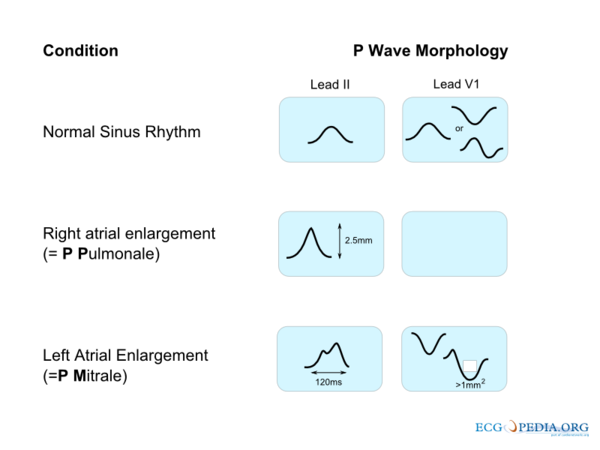P Wave Morphology: Difference between revisions
Jump to navigation
Jump to search
mNo edit summary |
mNo edit summary |
||
| Line 12: | Line 12: | ||
|editor= | |editor= | ||
}} | }} | ||
[[Image:normalSR.jpg|thumb|Normal sinus rhythm with a positive p wave in leads I, II en AVF and a biphasic p wave in V1.]] | |||
[[Image:p_wave_morphology.png|thumb|Altered P wave morfology is seen in left or right atrial enlargement.]] | |||
[[Image:pta_changes.svg|thumb|The PTa segment can be used to diagnose pericarditis or atrial infarction.]] | |||
The ''p wave morphology'' can reveal right or left atrial stretch. | The ''p wave morphology'' can reveal right or left atrial stretch. | ||
The P-wave morphology is best determined in leads II and V1 during sinus rhythm. | The P-wave morphology is best determined in leads II and V1 during sinus rhythm. | ||
{| class="wikitable" | {| class="wikitable" | ||
! Characteristics of a normal p wave:<cite>Spodick</cite> | ! Characteristics of a normal p wave:<cite>Spodick</cite> | ||
| Line 36: | Line 34: | ||
If the P wave is inverted, it is most likely an [[ectopic atrial rhythm]] not originating from the sinus node. | If the P wave is inverted, it is most likely an [[ectopic atrial rhythm]] not originating from the sinus node. | ||
{{clr}} | {{clr}} | ||
==Examples== | |||
<gallery> | |||
Image:Normaal ecg.jpg|thumb| An example of normal sinus rhythm. | |||
Image:Nsr.jpg|thumb| Another example of normal sinus rhythm. | |||
</gallery> | |||
==References== | ==References== | ||
<biblio> | <biblio> | ||
#Spodick pmid=1575201 | #Spodick pmid=1575201 | ||
</biblio> | </biblio> | ||
Revision as of 03:54, 8 February 2009
| «Step 4:Heart axis | Step 6: QRS morphology» |
| Author(s) | J.S.S.G. de Jong, MD, A. Bouhiouf, Msc | |
| Moderator | J.S.S.G. de Jong, MD | |
| Supervisor | ||
| some notes about authorship | ||



The p wave morphology can reveal right or left atrial stretch.
The P-wave morphology is best determined in leads II and V1 during sinus rhythm.
| Characteristics of a normal p wave:Spodick |
|---|
|
Elevation or depression of the PTa segment (the part between the p wave and the beginning of the QRS complex) can result from Atrial infarction or pericarditis.
If the p-wave is enlarged, the atria are enlarged.
If the P wave is inverted, it is most likely an ectopic atrial rhythm not originating from the sinus node.
Examples
-
An example of normal sinus rhythm.
-
Another example of normal sinus rhythm.
References
<biblio>
- Spodick pmid=1575201
</biblio>

